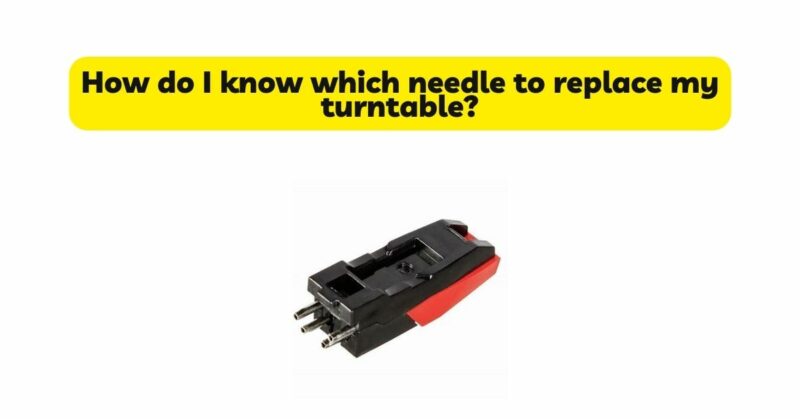If you’re a vinyl enthusiast or have recently acquired a turntable, you may find yourself in need of replacing the needle, also known as the stylus. Choosing the correct replacement needle for your turntable is crucial for preserving sound quality and ensuring optimal performance. In this article, we will provide you with a detailed guide on how to identify and select the right needle for your specific turntable model. By understanding the different types of needles, their compatibility, and key factors to consider, you can confidently navigate the process of replacing your turntable needle and continue enjoying your vinyl collection at its best.
I. Understanding Turntable Needles and Cartridges
To begin, let’s explore the basic components and functions of turntable needles and cartridges:
- Needle (Stylus): The needle, or stylus, is a small, diamond-tipped component that tracks the grooves of a vinyl record, translating the physical movements into electrical signals. It is responsible for accurately retrieving the audio information stored on the record’s surface.
- Cartridge: The cartridge houses the needle and converts the needle’s mechanical movements into electrical signals. It is an essential part of the turntable’s pickup system and can significantly influence the overall sound quality.
II. Identifying the Type of Needle
To determine the right replacement needle for your turntable, follow these steps:
- Check the Manufacturer and Model: Begin by identifying the manufacturer and model of your turntable. This information is typically located on the front or back of the turntable, the owner’s manual, or the manufacturer’s website.
- Research the Specifications: Once you have the turntable’s model, research the specifications and documentation related to your specific model. Look for information on the cartridge and needle compatibility provided by the manufacturer.
- Examine the Existing Needle: Take a close look at the existing needle on your turntable. Note its shape and design. Needles can come in various forms, such as conical, elliptical, or hyperelliptical. These shapes affect the way the needle tracks the grooves and impact the sound quality.
- Check for Any Markings: Some needles may have markings or codes engraved on them. These markings can provide important information about the needle’s compatibility and specifications. Use a magnifying glass if necessary to examine the needle closely.
III. Understanding Needle Compatibility
Consider the following factors to ensure needle compatibility with your turntable:
- Mounting Type: Needles come in different mounting types, such as standard mount (also known as half-inch mount) or P-mount (T4P) mount. Verify the mounting type required by your turntable before purchasing a replacement needle.
- Cartridge Compatibility: The needle is typically part of a cartridge assembly. Ensure that the replacement needle is compatible with the existing cartridge or consider replacing the entire cartridge if necessary.
- Tracking Force: Each needle has a specific tracking force range specified by the manufacturer. It is important to choose a replacement needle that matches or falls within the recommended tracking force range of your turntable.
IV. Factors to Consider When Choosing a Replacement Needle
When selecting a replacement needle, take the following factors into account:
- Sound Quality: Different needle shapes and designs can affect the sound quality. Elliptical or hyperelliptical needles are known for producing superior sound reproduction compared to conical needles.
- Record Condition: Consider the condition of your vinyl collection. If you have a significant number of older, worn, or rare records, a more forgiving needle profile may be preferable to minimize potential damage.
- Budget and Longevity: Replacement needles come in a range of prices, depending on their build quality and materials. Consider your budget and the expected lifespan of the needle when making a purchasing decision.
- Specialized Applications: If you have specific requirements, such as DJing or audiophile-grade listening, there may be specialized needles available to meet your needs. Research options that cater to your specific use case.
V. Tips for Replacing the Needle
Follow these tips when replacing the needle on your turntable:
- Handle with Care: Needles are delicate components, so handle them with care. Avoid touching the diamond tip and hold the needle by its base.
- Proper Alignment: Ensure the replacement needle is properly aligned with the cartridge. Refer to the manufacturer’s instructions or seek guidance from a professional if needed.
- Calibration and Tracking Force: Once the needle is replaced, calibrate and set the tracking force according to the manufacturer’s recommendations. This will ensure accurate tracking and minimize wear on your records.
Conclusion
Finding the right replacement needle for your turntable is crucial for maintaining sound quality and preserving the life of your records. By identifying the turntable’s model, researching specifications, understanding needle compatibility, and considering factors like sound quality, record condition, budget, and specialized applications, you can confidently select the appropriate replacement needle. Take care when handling and aligning the needle, and ensure proper calibration of tracking force for optimal performance. By following these guidelines, you can enhance your vinyl listening experience and continue to enjoy the rich, analog sound that vinyl records offer.


